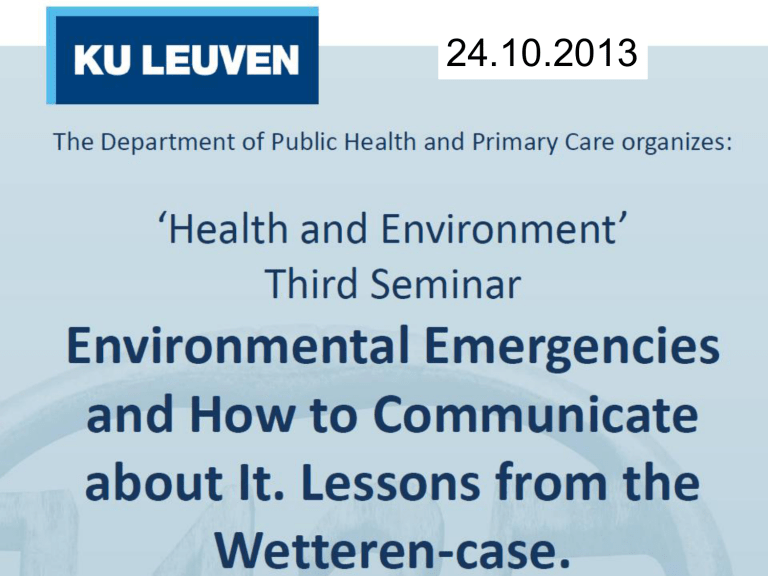
24.10.2013
Environmental emergencies
• Major chemical incident = “an event in
which a chemical causes, or threatens to
cause, a disaster”
• Chemical disaster = “an event in which a
chemical causes the death or injury of so
many people that the normal health and
emergency services are or threaten to
become overburdened”
Ferner RE. Pharmac. Ther. 1993, 58, 157-171
Chemical disasters
• Chemical warfare & terrorism
• Cl2, COCl2, mustard gas, sarin, ...
• Volcanic eruptions [Lake Nyos, 1986 (CO2)]
• Industrial disasters (fires, explosions, leaks, ...) &
transportation accidents (trains, trucks, ships, ...)
• Gases: NH3, AsH3, Cl2, Br2, COCl2, SO2, H2S, ...
CH3NCO [Bhopal, 1984]
• Complex chemicals: TCDD [Seveso, 1976], ...
• Food or water contamination
• TOCP, PCBs, HCB, HgCH3 [Minamata, 1956],
Toxic Oil Syndrome [Spain, 1981], As, Cd, ...
Bhopal
3 December 1984
Union Carbide pesticide plant
30 T methyl isocyanate (MIC, CH3-N=C=O)
± 150.000 people affected
6.000 - 10.000 severely affected
± 2.000 deaths in subsequent days
? with permanent damage
Time, 17 Dec 1984
Wetteren
• Saturday 04.05.2013, ~2 a.m.
• Freight train transporting chemicals derailed
→ fire/explosion + release of acrylonitrile
emergency response: firefighting +
evacuation of residents within 250 m
• health complaints + severe poisoning (incl.
1 death) outside evacuation area
= contamination of sewage system by
acrylonitrile
further evacuation of residents
Acrylonitrile
• CH2=CHCN
• Liquid, water soluble
• Volatile
• ―heavy‖ (AN/air = 1.8)
• 1 ppm ≈ 2.15 mg/m3
• ―sharp‖ odour: threshold 1.6-36.3 ppm,
clear 145 ppm
• (Rapid) broken down in air, water, soil
• Combustion → some HCN, NO2, ...
• Good respiratory absorption
Acrylonitrile
• Acute Exposure Guideline Levels (AEGLs)
• AEGL-1 (nondisabling): 4,6 ppm
• AEGL-2 (disabling): 290 ppm (10 min) – 8,6 ppm (8h)
• AEGL-3 (lethality): 480 ppm (10 min) – 19 ppm (8h)
• CDC-NIOSH:
• Immediately Dangerous to Life or Health (IDLH): 85 ppm
• NIOSH REL: 1 ppm TWA, 10 ppm 15-minute CEILING
• ACGIH: TLV 2 ppm TWA [skin], A2 [skin]
Acrylonitrile metabolism
CH2=CHCN
+ GSH
O
CH2—CHCN
CN
Metabolites in urine (CEMA),
SCN
Symptoms
• Acute exposure (< 24 h)
• Mucosal irritation
• Central Nervous System
Headache, nausea, dizziness
Consciousness ↘ → coma → death
Issues
• Emergency response
• Environmental contamination?
• Risks of long-term effects (especially
cancer)?
• Biomonitoring of human exposure
• Further monitoring of population?
• Communication !!!
Artsenkrant 17.05.2013
Artsenkrant 31.05.2013
24.10.2013
Administrative Issues
• Emergency response:
• Local and provincial authorities, civil protection
(Federal Ministry of Interior Affairs)
• Federal Public Service Health, Food Chain &
Environment
• Cell Disaster Management
• Federal Agency Food Safety
• Environmental issues
• Flemish Ministry of Environment
• Preventive health
• Flemish Ministry of Health
Advisory bodies
• Health Council (HGR-CSS)
• Advice to Ministry of Health
• Flemish Centre of expertise on Environment
and Health (Steunpunt Milieu &
Gezondheid)
• Institute of Public Health (WIV-ISP)
Epidemiology / Chemical Safety)
• Biomonitoring study
Biomonitoring van blootstelling aan
Acrylonitril
CH2=CHCN
+ GSH
O
CH2—CHCN
CN
Metabolieten in urine (CEMA), SCN
SNEL (uren – enkele dagen)
Biomonitoring van blootstelling aan
Acrylonitril
CH2=CHCN
O
CH2—CHCN
Rode bloedcel
(RBC)
HEMOGLOBINE
“Adduct”
Val-N—CH2—CH2CN
CyanoEthylValine (CEV)
CEV
(pmol/g globine)
CEV in Rode Bloedcellen
10000
1000
100
10
referentiewaarde
mei
juni
juli
Maanden
augustus
CEV
CEV in Rode Bloedcellen
10000
1000
100
10
mei
juni
juli
Maanden
augustus
CEV
CEV in Rode Bloedcellen
10000
1000
100
10
mei
juni
juli
Maanden
augustus
CEV
CEV in Rode Bloedcellen
10000
1000
100
10
mei
juni
juli
Maanden
augustus
Referentiewaarden voor CEV
• Niet-rokers: 10 pmol/g globine
• Rokers: 200 pmol/ g globine
• Die “referentiewaarden” werden bepaald op basis van
de statistische distributie van metingen bij mensen
zonder blootstelling aan acrylonitril (95e percentiel)
• Boven de referentiewaarde betekent niet “ziek” of “at
risk”, maar wel “blootgesteld” (licht, matig of hoog)
• “Referentiewaarde” voor rokers is enigszins dubieus
(100 tot 300 pmol/g globine)
CEV
CEV in Rode Bloedcellen
10000
1000
Rokers
100
10
Niet-Rokers
mei
juni
juli
Maanden
augustus
